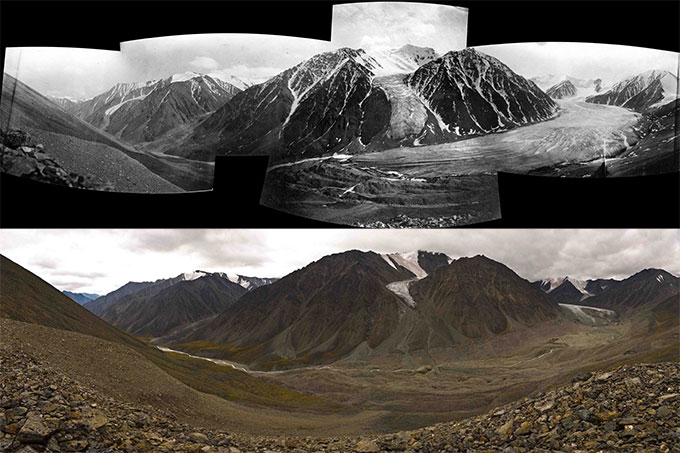February 11, 2015
By Rachel Rogol

Top: Okpilak Glacier, 1907. Photo by Ernest Leffingwell.
Bottom: Okpilak Glacier, 2007. Photo by Matt Nolan.
If a picture is worth a thousand words, Then & Now: The Changing Arctic Landscape—a traveling exhibition from the University of Alaska Museum of the North—speaks volumes about glacial retreat and the consequences of climate change in the Alaskan Arctic.
On view at Amherst College’s Beneski Museum of Natural History through April 19, 2015, Then & Now features photographs and media presentations that illustrate the startling effects of climate change, provide context about the Arctic ecosystem and illuminate the behind-the-photo stories of the consequences of climate change for Arctic indigenous peoples.
“The Beneski Museum has an impressive permanent display of large ice-age mammals—the mammoth and the mastodon, for example—that became extinct with the warming climate and receding continental ice sheets tens of thousands of years ago,” says Tekla Harms, Beneski Museum director and the College’s Massachusetts Professor in Chemistry and Natural History (Geology). “Then & Now helps us see how that process is continuing today with melting of the grand mountain glaciers in Alaska.”
The 23 large-format photographs hang on two floors of the museum, offering “before-and-after” views of the Alaskan Arctic by placing decades-old photos alongside contemporary images taken from the same vantage points. The result is a stunning reminder of the effects of climate change.
The two images pictured above, for example, illustrate that Alaska’s McCall Glacier has thinned considerably since 1973; one cirque glacier (right) has shrunk, and another (left) has disappeared completely.
The exhibition also includes a series of thought-provoking quote panels and presentations that provide visitors with an understanding of the deep cultural connection that Arctic indigenous residents have to this fragile land.
Museum of the North guest curator and ecologist Ken Tape, whose book The Changing Arctic Landscape inspired the exhibit, has been studying and photographing the Arctic for over a decade. “A visitor to the Arctic might be struck by the apparent timelessness and constancy of the place,” he says, “but that impression is misleading.” Tape’s images of the past and present lead one to wonder what these landscapes might look like in the future.
Then & Now: The Changing Arctic Landscape was produced by the University of Alaska Museum of the North with funding from the Rasmuson Foundation and contributions from Fairbanks Memorial Hospital/Denali Center, Holland America, Doyon Utilities, and Yukon Accounting. Exhibit toured by the Burke Museum, University of Washington. Local sponsorship for the exhibition is provided by the Dayton Fund of Amherst College.